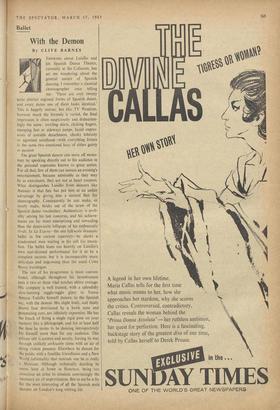Ballet
With the Demon
By CLIVE BARNES
,2 rnRy. pry THINKING about Luisillo and
his Spanish Dance Theatre, currently at the Coliseum, has set me wondering about the general nature of Spanish dancing. I remember a classical choreographer once telling me: 'There are over twenty
quite distinct regional forms of Spanish dance, and every damn one of them looks identical.' This is happily untrue; but like TV Westerns, however much the formula is varied, the final impression is often suspiciously and dishearten- ingly the same: swirling skirts, clicking fingers, stamping feet or sideways jumps, facial expres- sions of amiable detachment, cheeky lubricity or agonised sainthood—with everything frozen ir the same two emotional keys of either gaiety ol passion
The great Spanish dancer can stave off mono-
tony by speaking directly out to his audience in the personal esperanto known to great artists. For all that, few of them can sustain an evening's entertainment, because admirable as they may be as executants, they are not at heart creators. What distinguishes Luisillo from dancers like Antonio is that fate has put him at an unfair advantage by giving him a natural flair for choreography. Consequently he can make, or nearly make, bricks out of the straw of the Spanish dance vocabulary. Authenticity is prob- ably among his last concerns, and his achieve- ments are far more enterprising and rewarding than the dance-suite lollipops of his enthusiastic rivals. In La Espera—the one full-scale dramatic ballet in his current repertory—he shows a condemned man waiting in his cell for execu- tion. The ballet leans too heavily on Luisillo's own taut-skinned performance for it to be a complete success, but it is incomparably more articulate and engrossing than the usual Costa Brava travelogue.
The rest of his programme is more conven-
tional, although throughout his inventiveness puts it two or three vital notches above average. His company is well trained, with a splendidly slow-burning raggle-taggle gipsy in Teresa Amaya. Luisillo himself dances, as the Spanish say, with the demon. His slight body, and thinly drawn face dominated by a hawk nose and Penetrating eyes, are infinitely expressive. He has the knack of fixing a single rigid pose on your memory like a photograph, and for at least half the time he seems to be dancing introspectively for himself more than for any audience. This private self is austere and ascetic, forcing its way through unlikely corkscrew turns with an air of doing violent penance. Elsewhere he dances for the public with a faunlike friendliness and a New World informality that reminds one he is really a Mexican. Although technically dazzling he seems least at home in flamenco, being too conscious an artist to simulate convincingly the necessary air of improvisation. But to me he is by far the most interesting of all the Spanish male dancers on London's long visiting list.






































 Previous page
Previous page